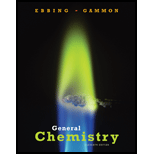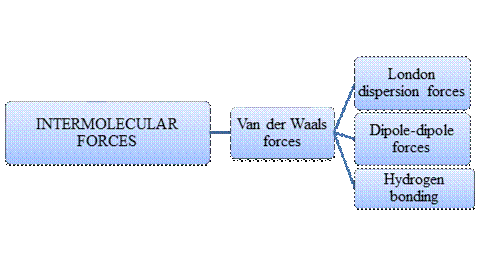
General Chemistry
11th Edition
ISBN: 9781305859142
Author: Ebbing, Darrell D., Gammon, Steven D.
Publisher: Cengage Learning,
expand_more
expand_more
format_list_bulleted
Question
Chapter 11, Problem 11.14QP
Interpretation Introduction
Interpretation:
The molecular substances have moderately low melting point. This is to be explained.
Concept introduction:
Intermolecular forces are termed as the forces acting “between molecules” that is components of a substance. Intramolecular forces are the forces that operate “within a molecule”. The prefix “inter” mean “among” and “intra” mean “within”.

Arrangement of major types of intermolecular forces in increasing order of strength:
Expert Solution & Answer
Want to see the full answer?
Check out a sample textbook solution
Students have asked these similar questions
Organise the molecular structure in order of increasing boiling point. Explain why.
Would you predict the melting point of the following substances to be high or low? Explain why.
CaCl2
PCl5
Zn
Why do salt crystals have a cubical shape?
Chapter 11 Solutions
General Chemistry
Ch. 11.2 - The heat of vaporization of ammonia is 23.4...Ch. 11.2 - Shown here is a representation of a closed...Ch. 11.2 - Prob. 11.2ECh. 11.2 - Selenium tetrafluoride, SeF4, is a colorless...Ch. 11.3 - Prob. 11.4ECh. 11.3 - When camping at high altitude, you need to pay...Ch. 11.5 - Consider two liquids, labeled A and B, that are...Ch. 11.5 - List the different intermolecular forces you would...Ch. 11.5 - Arrange the following hydrocarbons in order of...Ch. 11.5 - At the same temperature, methyl chloride, CH3Cl,...
Ch. 11.5 - A common misconception is that the following...Ch. 11.6 - Prob. 11.8ECh. 11.6 - Prob. 11.9ECh. 11.7 - Figure 11.35 shows solid dots (atoms) forming a...Ch. 11.8 - Shown here is a representation of a unit cell for...Ch. 11.9 - Lithium metal has a body-centered cubic structure...Ch. 11.9 - Potassium metal has a body-centered cubic...Ch. 11 - List the different phase transitions that are...Ch. 11 - Describe how you could purify iodine by...Ch. 11 - Prob. 11.3QPCh. 11 - Explain why 15 g of steam at 100C melts more ice...Ch. 11 - Why is the heat of fusion of a substance smaller...Ch. 11 - Explain why evaporation leads to cooling of the...Ch. 11 - Describe the behavior of a liquid and its vapor in...Ch. 11 - Gases that cannot be liquefied at room temperature...Ch. 11 - Prob. 11.9QPCh. 11 - Why does the vapor pressure of a liquid depend on...Ch. 11 - Prob. 11.11QPCh. 11 - Prob. 11.12QPCh. 11 - Prob. 11.13QPCh. 11 - Prob. 11.14QPCh. 11 - Prob. 11.15QPCh. 11 - Prob. 11.16QPCh. 11 - Prob. 11.17QPCh. 11 - What is the coordination number of Cs in CsCl? of...Ch. 11 - Explain in words how Avogadros number could be...Ch. 11 - Prob. 11.20QPCh. 11 - Prob. 11.21QPCh. 11 - Prob. 11.22QPCh. 11 - Under the right conditions, hydrogen gas, H2, can...Ch. 11 - An element crystallizes with a simple cubic...Ch. 11 - Intermolecular Forces The following picture...Ch. 11 - Heat and Molecular Behavior Part 1: a Is it...Ch. 11 - Shown here is a curve of the distribution of...Ch. 11 - Consider a substance X with a Hvap = 20.3 kJ/mol...Ch. 11 - Prob. 11.29QPCh. 11 - Prob. 11.30QPCh. 11 - Prob. 11.31QPCh. 11 - Prob. 11.32QPCh. 11 - Prob. 11.33QPCh. 11 - Prob. 11.34QPCh. 11 - Prob. 11.35QPCh. 11 - Prob. 11.36QPCh. 11 - Prob. 11.37QPCh. 11 - Prob. 11.38QPCh. 11 - Use Figure 11.7 to estimate the boiling point of...Ch. 11 - Use Figure 11.7 to estimate the boiling point of...Ch. 11 - An electric heater coil provided heat to a 15.5-g...Ch. 11 - Prob. 11.42QPCh. 11 - Isopropyl alcohol, CH3CHOHCH3, is used in rubbing...Ch. 11 - Liquid butane, C4H10, is stored in cylinders to be...Ch. 11 - Water at 0C was placed in a dish inside a vessel...Ch. 11 - A quantity of ice at 0.0C was added to 33.6 g of...Ch. 11 - A quantity of ice at 0C is added to 64.3 g of...Ch. 11 - Steam at 100C was passed into a flask containing...Ch. 11 - Chloroform, CHCl3, a volatile liquid, was once...Ch. 11 - Prob. 11.50QPCh. 11 - White phosphorus, P4, is normally a white, waxy...Ch. 11 - Carbon disulfide, CS2 is a volatile, flammable...Ch. 11 - Prob. 11.53QPCh. 11 - Prob. 11.54QPCh. 11 - Prob. 11.55QPCh. 11 - Prob. 11.56QPCh. 11 - Which of the following substances can be liquefied...Ch. 11 - A tank of gas at 21C has a pressure of 1.0 atm....Ch. 11 - Prob. 11.59QPCh. 11 - Krypton, Kr, has a triple point at 169C and 133...Ch. 11 - Prob. 11.61QPCh. 11 - The heats of vaporization of liquid O2, liquid Ne,...Ch. 11 - For each of the following substances, list the...Ch. 11 - Which of the following compounds would you expect...Ch. 11 - Arrange the following substances in order of...Ch. 11 - Arrange the following substances in order of...Ch. 11 - Methane, CH4, reacts with chlorine, Cl2, to...Ch. 11 - The halogens form a series of compounds with each...Ch. 11 - Prob. 11.69QPCh. 11 - Prob. 11.70QPCh. 11 - List the following substances in order of...Ch. 11 - Arrange the following compounds in order of...Ch. 11 - Classify each of the following by the type of...Ch. 11 - Classify each of the following by the type of...Ch. 11 - Classify each of the following solid elements as...Ch. 11 - Which of the following do you expect to be...Ch. 11 - Prob. 11.77QPCh. 11 - Arrange the following substances in order of...Ch. 11 - Prob. 11.79QPCh. 11 - On the basis of the description given, classify...Ch. 11 - Prob. 11.81QPCh. 11 - Associate each of the solids BN, P4S3, Pb, and...Ch. 11 - Prob. 11.83QPCh. 11 - How many atoms are there in a body-centered cubic...Ch. 11 - Metallic iron has a body-centered cubic lattice...Ch. 11 - Nickel has a face-centered unit cell with all...Ch. 11 - Copper metal has a face-centered cubic structure...Ch. 11 - Barium metal has a body-centered cubic lattice...Ch. 11 - Gold has cubic crystals whose unit cell has an...Ch. 11 - Chromium forms cubic crystals whose unit cell has...Ch. 11 - Assume X has a body-centered cubic lattice with...Ch. 11 - Lead has a face-centered cubic lattice with all...Ch. 11 - Prob. 11.93QPCh. 11 - Metallic barium has a body-centered cubic...Ch. 11 - Prob. 11.95QPCh. 11 - Prob. 11.96QPCh. 11 - Prob. 11.97QPCh. 11 - Prob. 11.98QPCh. 11 - Prob. 11.99QPCh. 11 - Prob. 11.100QPCh. 11 - Prob. 11.101QPCh. 11 - Prob. 11.102QPCh. 11 - Describe the formation of hydrogen bonds in...Ch. 11 - Prob. 11.104QPCh. 11 - Ethylene glycol (CH2OHCH2OH) is a slightly viscous...Ch. 11 - Pentylamine, CH3CH2CH2CH2CH2NH2, is a liquid that...Ch. 11 - Prob. 11.107QPCh. 11 - Prob. 11.108QPCh. 11 - Decide which substance in each of the following...Ch. 11 - Prob. 11.110QPCh. 11 - Iridium metal, Ir, crystallizes in a face-centered...Ch. 11 - The edge length of the unit cell of tantalum...Ch. 11 - Prob. 11.113QPCh. 11 - Rubidium metal has a body-centered cubic structure...Ch. 11 - Calculate the percent of volume that is actually...Ch. 11 - Calculate the percent of volume that is actually...Ch. 11 - For the hydrogen halides and the noble gases, we...Ch. 11 - For the carbon and nitrogen family hydrides, we...Ch. 11 - Prob. 11.119QPCh. 11 - Prob. 11.120QPCh. 11 - Prob. 11.121QPCh. 11 - Prob. 11.122QPCh. 11 - Prob. 11.123QPCh. 11 - Prob. 11.124QPCh. 11 - A geckos toes have been shown to stick to walls...Ch. 11 - Prob. 11.126QPCh. 11 - Prob. 11.127QPCh. 11 - Prob. 11.128QPCh. 11 - Prob. 11.129QPCh. 11 - Prob. 11.130QPCh. 11 - Prob. 11.131QPCh. 11 - Prob. 11.132QPCh. 11 - In an experiment, 20.00 L of dry nitrogen gas, N2,...Ch. 11 - On a particular summer day, the temperature is...Ch. 11 - Prob. 11.135QPCh. 11 - Prob. 11.136QPCh. 11 - Prob. 11.137QPCh. 11 - Prob. 11.138QPCh. 11 - Prob. 11.139QPCh. 11 - Prob. 11.140QPCh. 11 - Rhenium forms a series of solid oxides: Re2O7...Ch. 11 - Shown below is the cubic unit cell of an ionic...Ch. 11 - Prob. 11.143QPCh. 11 - Strontium crystallizes as a face-centered cubic...Ch. 11 - Prob. 11.145QPCh. 11 - Prob. 11.146QPCh. 11 - Prob. 11.147QPCh. 11 - Prob. 11.148QPCh. 11 - Prob. 11.149QPCh. 11 - Prob. 11.150QPCh. 11 - Prob. 11.151QPCh. 11 - Prob. 11.152QPCh. 11 - How much heat must be added to 28.0 g of solid...Ch. 11 - Prob. 11.154QPCh. 11 - Prob. 11.155QPCh. 11 - Prob. 11.156QPCh. 11 - Nanotechnology, or technology utilizing 1100 nm...
Knowledge Booster
Learn more about
Need a deep-dive on the concept behind this application? Look no further. Learn more about this topic, chemistry and related others by exploring similar questions and additional content below.Similar questions
- Which of the following sets of compounds do we expect to have the same boiling point?arrow_forwardExplain why the melting point of methyl fluoride, CH3F (-142°C), is higher than the melting point of methane, CH4 (-182°C)?arrow_forwardChoose the substance with the highest boiling point and explain why you choose it -NaCl -H2O -O3 -CH4arrow_forward
- Which type(s) of molecular forces are present in the compound SF2?arrow_forwardWhich intermolecular forces will be present in the substance SF4?arrow_forwardChoose the compound that has the lowest surface tension. (Consider intermolecular forces) Не Tete Li Be B Ne 12 14 15 16 17 Na Mg Al Si ci Ar 19 20 21 22 23 24 26 27 28 29 31 33 34 35 36 K Ca Sc Ti V Cr Mn Fe Co Ni Cu Zn Ga Ge As Se Br Kr 47 64 41 Rb Sr Y Zr Nb Mo Tc Ru Rh Pd Ag Cd In Sn Sb Te Хе ST-70 71 72 74 76 77 Cs Ba Lu Hf Ta W Re Os Ir Pt Au Hg TI Pb Bi Po At Rn STAL 3-102 103 104 185 106 187 108 110 111 112 114 Fr Ra Lr Rf Db Sg Bh Hs Mt Uun Uuu Uub Uuq 70 *Lanthanide series La Ce Pr Nd Pm Sm Eu Gd Tb Dy Ho Er Tm Yb **Actinide series 100 101 102 Ac Th Pa Np Pu Am Cm Bk Cf Es Fm Md No Select one: O a. HOCH;CH;OH OB CH;CH2CH2NH2 Oc CH;COOH Od CH;CH2CH2OHarrow_forward
- Iodine is a solid at room temperature (mp = 113.5 °C) while bromine is a liquid (mp = -7 °C). Explain this difference in terms of intermolecular forces.arrow_forwardWhat effect does intermolecular bond strength have on boiling points?arrow_forwardCl2 has A boiling point of -34 Celsius while krypton has a boiling point of -153 Celsius. why is the boiling point of chloride higher. Neither of them have a dipole.arrow_forward
arrow_back_ios
SEE MORE QUESTIONS
arrow_forward_ios
Recommended textbooks for you
 General Chemistry - Standalone book (MindTap Cour...ChemistryISBN:9781305580343Author:Steven D. Gammon, Ebbing, Darrell Ebbing, Steven D., Darrell; Gammon, Darrell Ebbing; Steven D. Gammon, Darrell D.; Gammon, Ebbing; Steven D. Gammon; DarrellPublisher:Cengage Learning
General Chemistry - Standalone book (MindTap Cour...ChemistryISBN:9781305580343Author:Steven D. Gammon, Ebbing, Darrell Ebbing, Steven D., Darrell; Gammon, Darrell Ebbing; Steven D. Gammon, Darrell D.; Gammon, Ebbing; Steven D. Gammon; DarrellPublisher:Cengage Learning
 Chemistry: An Atoms First ApproachChemistryISBN:9781305079243Author:Steven S. Zumdahl, Susan A. ZumdahlPublisher:Cengage Learning
Chemistry: An Atoms First ApproachChemistryISBN:9781305079243Author:Steven S. Zumdahl, Susan A. ZumdahlPublisher:Cengage Learning ChemistryChemistryISBN:9781305957404Author:Steven S. Zumdahl, Susan A. Zumdahl, Donald J. DeCostePublisher:Cengage Learning
ChemistryChemistryISBN:9781305957404Author:Steven S. Zumdahl, Susan A. Zumdahl, Donald J. DeCostePublisher:Cengage Learning
 Chemistry: The Molecular ScienceChemistryISBN:9781285199047Author:John W. Moore, Conrad L. StanitskiPublisher:Cengage Learning
Chemistry: The Molecular ScienceChemistryISBN:9781285199047Author:John W. Moore, Conrad L. StanitskiPublisher:Cengage Learning

General Chemistry - Standalone book (MindTap Cour...
Chemistry
ISBN:9781305580343
Author:Steven D. Gammon, Ebbing, Darrell Ebbing, Steven D., Darrell; Gammon, Darrell Ebbing; Steven D. Gammon, Darrell D.; Gammon, Ebbing; Steven D. Gammon; Darrell
Publisher:Cengage Learning


Chemistry: An Atoms First Approach
Chemistry
ISBN:9781305079243
Author:Steven S. Zumdahl, Susan A. Zumdahl
Publisher:Cengage Learning

Chemistry
Chemistry
ISBN:9781305957404
Author:Steven S. Zumdahl, Susan A. Zumdahl, Donald J. DeCoste
Publisher:Cengage Learning


Chemistry: The Molecular Science
Chemistry
ISBN:9781285199047
Author:John W. Moore, Conrad L. Stanitski
Publisher:Cengage Learning
Chemical Equilibria and Reaction Quotients; Author: Professor Dave Explains;https://www.youtube.com/watch?v=1GiZzCzmO5Q;License: Standard YouTube License, CC-BY